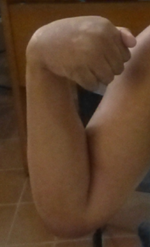Spasticity is a neuro-muscular disorder causing tightness of some muscles, leading to impairment of movement, and deformities.
It is usually caused by damage to the portion of the brain or spinal cord that controls voluntary movement. It may affect only one side of the body (hemiplegia) or all four limbs (tetraplegia or tetraparesia).
It is estimated to affect more than 12 million people worldwide, including a large number of children.
Treatment should be initiated as early as possible. It consists mostly in rehabilitation (physiotherapy and occupational therapy), splints (to correct, or prevent deformities), injections of botulinum toxin (very effective in selected cases, but with temporary effect).
Surgery has been performed for many years in the lower limb, but is not very common in the upper limb yet. New developments in clinical research and methods of evaluation now allow us to perform more operations on the shoulder, elbow, wrist and hand of spastic patients with safe and predictable results.
This site is more specifically dedicated to the surgical treatment of the upper limb of spastic patients.







